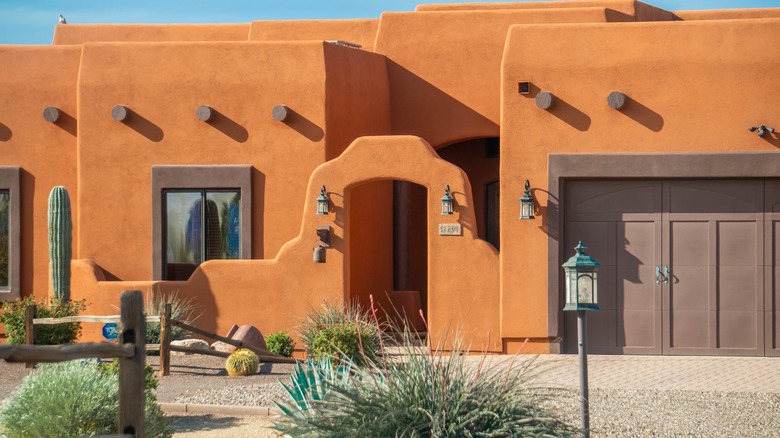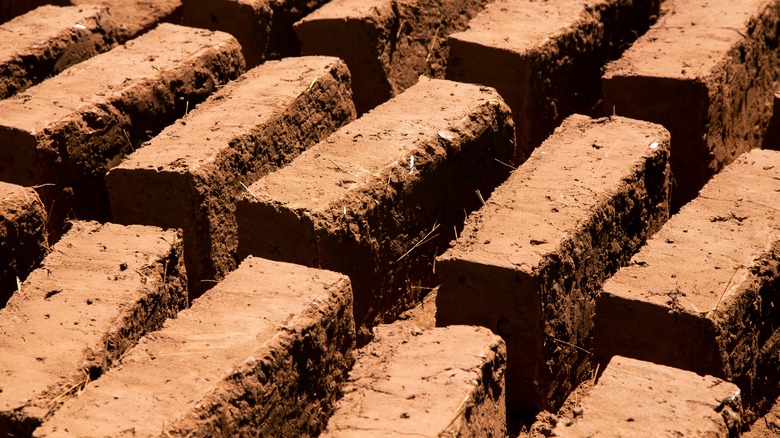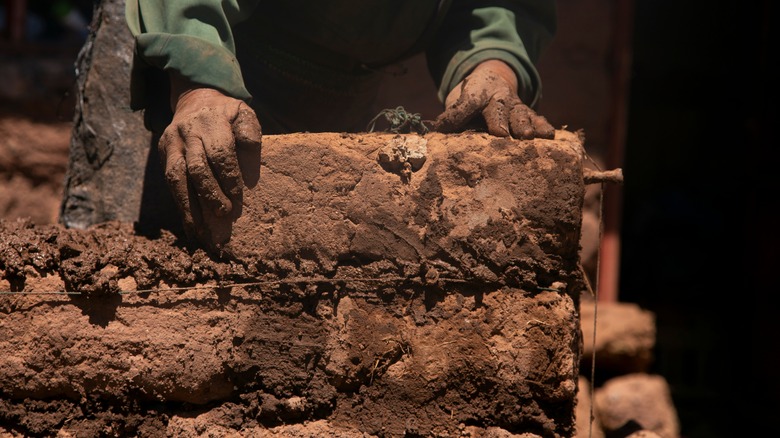The Benefits And Drawbacks Of Living In An Eco-Friendly Adobe House
The building and construction industry shoulders the blame for 37 percent of global greenhouse gas (GHG) emissions (per UNEP — the United Nations Environment Programme). As such, the sector has a high carbon footprint, with the manufacturing and application of ubiquitous materials like steel, cement, and aluminum accounting for the lion's share — 23 percent — of the GHG emissions. Consequently, the UNEP advocates trading conventional building materials with eco-friendly ones, as this could reduce the emissions in this sector by 40 percent. Enter adobe houses, which can alleviate these issues, but have some unique drawbacks.
These mud-brick houses are an excellent example of bio-based buildings since they're primarily made of earth, containing silt, clay, sand, and water. Additionally, organic fibrous items like straw, dung, or grass are added to the mix to help bind the earth and water concoction. Fabled to be popular in Jericho in 8300 BC and with its lineage tracing back to the Indigenous Pueblos of southwest America, the adobe architecture has stood the test of time and can still be found in dry and arid locations, like New Mexico, Arizona, Florida, and California. Given their sustainability, using mud bricks is the first step toward designing your home with sustainable materials. But before you build or lease an earthen house, it's important to understand both sides of the coin, aka their pros and cons.
Reasons you should consider living in eco-friendly adobe houses
Adobe houses are eco-friendly. Composed of natural materials, the required raw ingredients are abundant and can be found locally. This not only reduces the need for factory-manufactured materials but also saves energy used to transport the produced items. Moreover, the mud bricks absorb heat during the day, keeping the interiors cool and reducing the need for cooling devices when the sun is out. Conversely, they release the stored heat at night when the temperature cools down, so you won't have to look into the different options to heat your home to sleep comfortably at night.
Simply put, adobe houses are energy-efficient. They can conserve around 370 GJ (gigajoules) of energy annually. Since 1 GJ equals 1 billion joules or 227.8 kWh (kilowatt hours), they can help reduce your energy costs at home. Unsurprisingly, earthen homes have an energy payback time — the time taken to regenerate the amount of energy it took to build the home — of a mere 1.54 years. Plus, they're incredibly durable and can stand tall for hundreds of years. Case in point: Taos Pueblo in New Mexico, a community of adobe homes and a UNESCO World Heritage site, which was reportedly built 1000 years ago and is still home to a few people.
Additionally, the materials are biodegradable and can withstand earthquakes (given they're adequately reinforced). Add budget-friendliness, fire-resistance, and soundproofing to the mix, and it can be difficult to say no to earthen houses.
Drawbacks of eco-friendly adobe houses
Even though adobe houses are the epitome of a green flag, they come with their fair share of baggage. For starters, these homes require a significant time and effort investment, meaning it takes a considerable amount of time to turn earth and other organic materials into mud bricks, and then stack them to resemble a functional house. You also need skilled professionals to get the job done and ensure the structure is compliant with building codes and permits. While necessary, hiring skilled labor will increase the cost of the project.
Another key drawback is that earthen houses are fit for hot and arid locations only. They can't withstand cold temperatures or heavy rainfall. Further, insects can manipulate the tiny gaps in the walls and make their way inside your home. Insulation can be an issue and the house might succumb to natural disasters, like floods, and harsh climates, like those where gales are typical, because it isn't as strong as concrete.
Since constant temperature changes, strong winds, and water can erode the bricks and harm the house, it's important to maintain the house regularly. To elaborate, you'll have to keep your eyes peeled for signs of distress and give it a slurry wash once in a while. Moreover, you need to repair holes and cracks with protective plaster like lime to minimize moisture absorption. Ultimately, the decision is yours; if you don't mind the maintenance and live in a dry region, eco-friendly adobe houses might make a great home.



